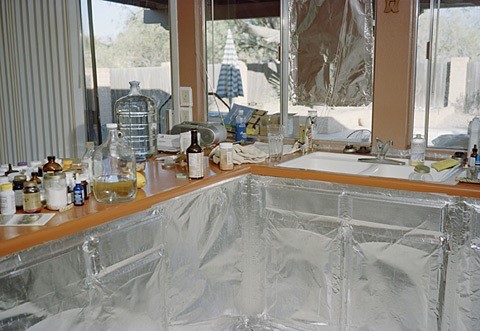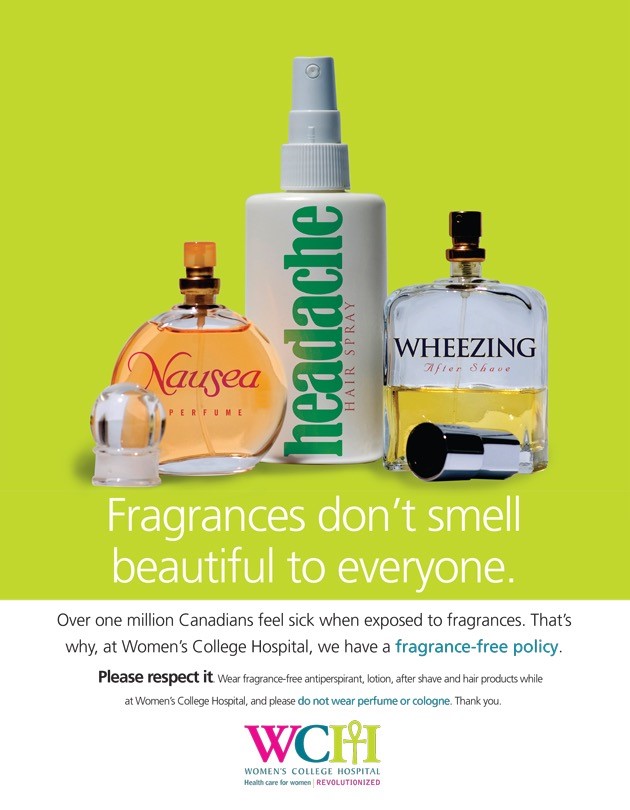Sophia Jaworski, Doctoral Candidate in Anthropology, University of Toronto
I speak with a visual artist who has been displaced from multiple residences and is sleeping in a minivan. On social assistance, she is in the difficult situation of trying to find a place to rent that is safe for her accessibility needs. She has intense nervous system reactions to cigarette smoke and fragrance, which, from her experience, most apartment buildings she can afford contain in large amounts. She explains to me that unfortunately many low income rental buildings have smells and odours that transcend hallways and walls, creep under doors, or leak through air vents and windows. In her van she uses tinfoil to prevent the off-gassing of the ‘new car smell’ that takes years to leave the plastic interior dashboard, steering wheel, and trunk space. She strategically places small piles of white baking powder to absorb scents that come in through the open windows. “I’ve gotten used to it now” she tells me, talking about how the weird looks she gets from people outside on the street, who peer into her home curiously.
For chemically sensitive individuals, everyday spaces such as offices, supermarkets and buses contain exposures that cause reactions which last for hours or days. Many seemingly benign household products, home furnishings, and building materials actually contain small amounts of toxic chemicals that fugitively leak into everyday atmospheres, despite little being known about the long-term effects of low-level indoor emissions. Mounting evidence suggests that the release of petrochemically-derived chemical substances, as well as volatile organic compounds, pesticides, heavy metal dusts, fragranced personal care products, and cleaning products into the “exposome” of the air (Wild 2005), such as through office renovations, roof tarring, cleaning sprays, or new furniture, has severe consequences. Products such as gold food spray paint elaborately wafting from a basted turkey immediately come to mind, but the culprits are really more ordinary substances like dish soap, lotion, paint, or diesel.

In Canada, over a million people, predominantly women, experience Environmental Sensitivities (ES), i.e., chronic multi-system physical reactions to even minimal amounts of toxic chemical exposure. Although it is little known, the population rate of chemical sensitivities in Canada (1.7%) is comparable to all cancers combined (2.2%). There has been a 31% increase in ES diagnoses between 2005 and 2010, yet environmental policies and toxicological paradigms continue to silo increased industrial chemical production from recognition of its effects on health and well-being. Studying the complex contexts of petrochemicals in Toronto, Ontario, Canada, I grapple with the uncanny reality of homes and workplaces as sites where bodily harm can be surreptitiously experienced in the midst of ordinary surroundings. I try to unravel the uneven relational politics of scenarios such as how smelling the perfume of a passerby on the street can make one person feel like they smell nice, and another person have a migraine and dizziness. How to contend with settings where one person who likes to smoke inside, means that another person in the apartment next door, whenever they are home just trying to relax, has difficulty breathing, body pain, and trouble concentrating?
While several EU countries and a few US states have regulations that inform consumers which commodities contain potentially toxic substances, Canada allows the unregulated commercial use of chemicals in homes and workplaces until proven toxic. The 2006 Chemical Management Plan has assessed 3,500 toxic substances thus far of the more than 80,000 in circulation, yet created risk management practices for only ninety out of 457 of concern. Current discourses frame perceptions of chemicals, as banal toxicity, and these perspectives inherently preclude exposure prevention. Symptoms of severe toxic reactions are routinely dismissed as psychosocial distress, despite how increasing reliance on the socio-economic value of toxic substances reconfigures everyday cultural practices in gendered ways, and materially redefines the mundane slippages between petrochemical and corporeal mediums.
As climate change activists have been asserting for decades, the environmental stakes of a human-altered world are reaching a fever pitch. Yet in Ontario, the failure of environmental issues to be taken seriously is demonstrated by Provincial government actions such eliminating the independent, non-partisan office of the Legislature of Environmental Commissioner of Ontario (ECO).
My research includes working with women who experience ES, specialists in environmental medicine, and housing activists. For us, it is crucial to disrupt the ephemerality of fumes, to articulate how the lifelong effects of indoor everyday chemical exposure do not occur in isolation. What questions can be asked when we take seriously how the reverberations of a stranger’s perfume amplify constellations of vulnerability sustained by a climate of financial austerity and Toronto’s citywide housing crisis?
The challenge is to articulate the significance of everyday chemical worlds’ toxicological legacies. Their permutations are complex, little understood, and highly contested. For many women, it is only after many enigmatic years of seeing multiple specialists and diagnostic tests when they come to link what they experience to ES. Difficult to tie to a particular event, chemical harm occurs slowly over time as exposures accumulate into what environmental medicine practitioners call an overwhelmed ‘total load.’ This term describes a sort of threshold reached by those with chemical sensitivities when the body can no longer successfully process toxic substances without adverse effects. Yet, it begs the question of rethinking how paradigms of “toxicity,” “risk,” and “exposure,” reinforce late-liberal notions of individual responsibility that exempt industry accountability, and reinforce disparaging binaries of insides and outsides, sameness and difference.

Critiquing the established sociocultural values of common sources of everyday exposure is not straightforward, especially when chemically containing products such as personal care products, cleaning products, furniture, clothing, and household improvement products are embedded in rhetorics of self-care, material progress, development, and repair. Yet for those with ES, when these substances are avoided and removed, such as carpet backing cocktails, or the daily average of 168 chemicals in personal care products is reduced, health improves dramatically. A chemically sensitive person’s ability to access to public spaces, including workplaces and public transportation, becomes contingent on strange negotiations around shared atmosphere, and attempts to control the amorphous trajectories of fume spirals as they emanate from the products they are embedded in. Most people are not aware chemicals with known or suspected acute and long-term toxicity to human, animal, and ecosystem life exist everywhere, sedimenting in us all the time.

If individuals with ES are lucky enough to have a workplace which implements a scent-free policy, may find that it is inconsistently, or rarely enforced. It becomes even more complex when navigating public transportation, or accessing a health care facility, navigating the hundreds and thousands of human-chemical clouds, crowds emanating extracted synthesized organic compounds distilled onto commodity objects, building materials, and their bodies.
The chronic progression of environmental illness and ES, especially when untreated, can lead to a high level of functional disability. The challenge remains, how can we name, and disrupt the wider implications that low-level, life-time, toxic chemical exposures have for being-together in the world? How does this intersect with feminist, anti-colonialist, and anti-racist principles? For women who cannot find safe housing, are displaced from their jobs, and cannot access disability benefits because their illness and or disability is not deemed legitimate, how do we resist displacement? How do we imagine otherwise?
Building on an anthropology of late industrialism, I position the indoor embodiment of emergent classes of toxic substances, and burgeoning claims to toxic exposure, as central to critiques of historical exclusion of chemicals from social concepts of vulnerability, and relegation into cultural and political non-places. At a time when scholars of our Anthropocene world are being called to interrogate how the settler atmospherics of urban colonization continue to reconstitute the relational terrains of municipal life in gendered, classed and raced ways, I extend this work to include the critical industrial cultural production of chemical infrastructures in the commodities and materials that are the matter of urban life.
There is currently the need for a radical approach to re-imagining our collective chemical futures amongst researchers and community members alike. Chemical regulation alone cannot bridge environmental justice and social justice, as well as critically address silos between public health, medicine, social policy, environmental law and conservation, chemical engineering and toxicology, and critical perspectives of commodity capitalism. Although it is important to think seriously about the sudden lack of appeal of grey jelly beans without artificial colours derived from petroleum, this is a systems issue that runs deep into our very perceptions of what commodity consumption means, what a right to housing means, and what a right to participate and access public space means.
The fights for human rights to safe housing by communities exposed to geographically endorsed proximities to toxic chemicals continue. While these struggles need all of our support to demand state accountability for this type of slow violence, the settings for such violence need to be broadened beyond industrial plants and factories that disproportionately affect the communities around them. Our understandings of chemical exposures need to include the spaces in which we spend the majority of our time, and the ways in which those spaces are materially composed. Certain occupations have higher likelihood of chemical exposure, and certain factors contribute to the ability to mitigate higher chemical exposure in the home, such as lower income. Refuting damage centred narratives that reify and depoliticize individuals effected by chemical exposure requires acknowledging our mutual permeability, the continuous relational fraying of public and private contexts, individual and community. Elevating the issue of petrochemical industry profit requires that we continue to build allyship, resilience, and solidarity, across indigenous land and water protectors, grassroots community building organizations, activists, consumers, marketers, policy makers, stakeholders, and everyday people.
If infrastructures of petrochemicals alter the politics of relation, then tracing the complex everyday forms of lived intimacies with chemicals open new embodied understandings of an all-too-human conundrum: being at home in the world. These understandings do not promote the erasure of ongoing extractive colonialism by relying on unproblematized universal notions of human subjects, but rather emphasize how uneven configurations of power, patriarchy, and capitalism are invariably involved in processes of prescribing chemical co-constitution to form, and in turn the co-constitution of our relation with the indoor geographies of everyday urban life.
